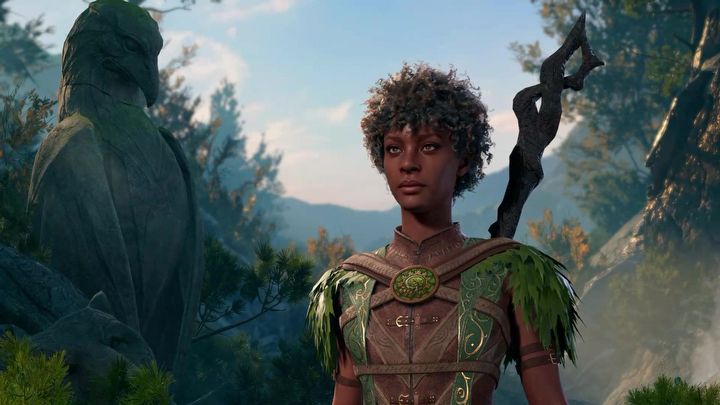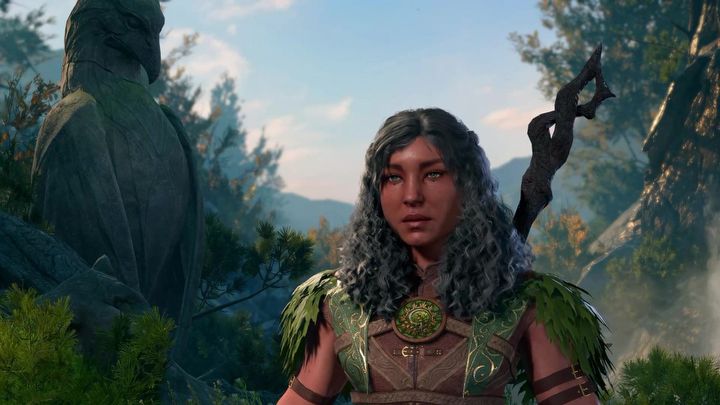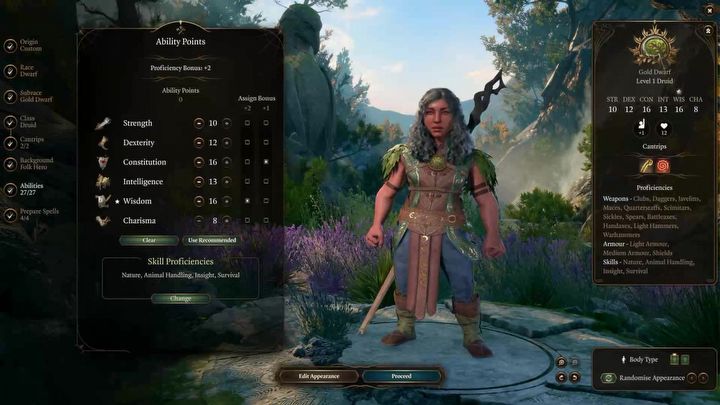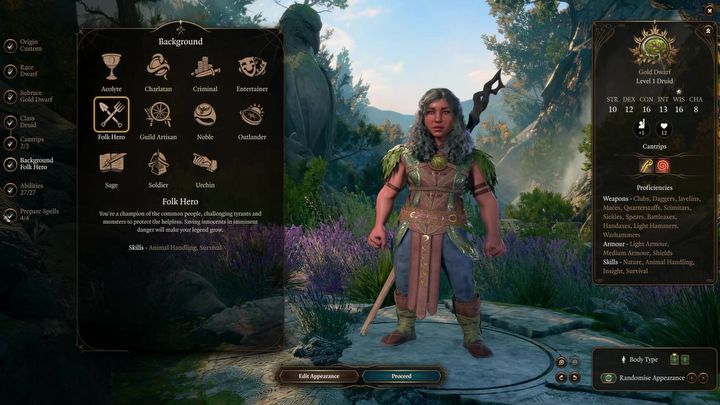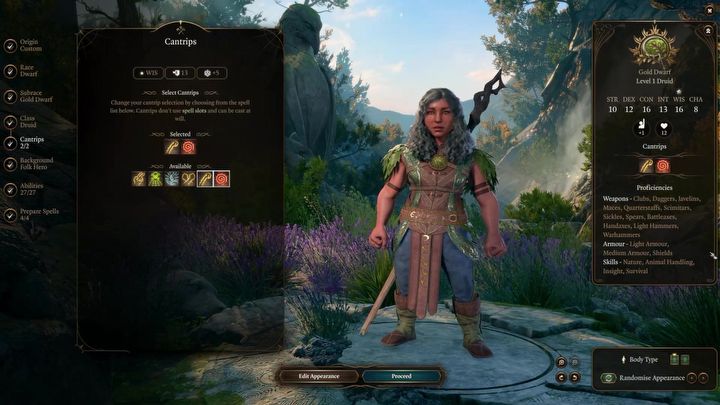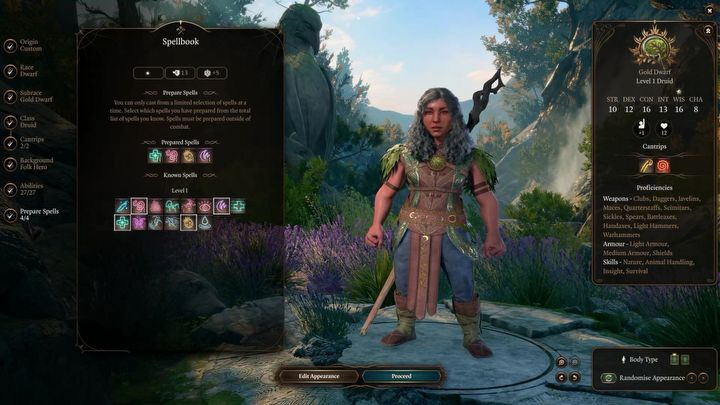Baldur's Gate 3: Druid guide BG3
Are you having trouble creating a Druid in Baldur's Gate 3? This page will help you build an optimal nature-harnessing spellcaster.
Last update:
Druids in the world of Baldur's Gate 3 are mages who draw their power from a special bond that connects them with the world of nature. These persistent warriors can fulfill many roles in the party: from being supportive mages to ruthless brutes smashing enemies with their powerful fangs and claws. The following page presents a set of basic information that will help you determine what type of Druid will be best for you.
- The best race for a Druid
- Ability points
- The best origin for a Druid
- Wild Shape
- The best form
- Best spells for a Druid
- Best subclass
- Best build for a Druid
Best race for a Druid
The dominant ability for a Druid is definitely Wisdom. Unfortunately, none of the available races offer a starting +2 bonus to this particular stat. Among those that offer modifier 1, the following races should be considered:
- Human offering a +1 bonus to all abilities, including, of course, Wisdom.
- Wood Elf with +2 bonus to Dexterity and 1+ to Wisdom. This subrace gives access to useful proficiency in using bows and an increased base speed.
- Gold Dwarf, who besides providing a +1 to Wisdom will also have access to racial abilities, which will help you create a somewhat more resistant Druid who can take more hits.
Ability Points
When assigning ability points, first pay attention to a high Wisdom indicator, as it is responsible for the strength of the spells cast by the Druid.
Secondly, focus on Constitution and Dexterity.
- Constitution will allow your Druid to endure a bit more during intense clashes, and will also make it easier for you to stay focused when casting spells that require concentration.
- High Dexterity will provide you with several additional armor class points when using medium and light armor - Druids are naturally proficient in using them.
The best origin for a Druid
When choosing origins for your Druid, try to choose those that will provide you with proficiency in skills based on Wisdom. In a complementary way, this will enhance the strengths of your character and allow you to easily handle dice rolls. Origins worth considering are among others. e.g.
- Hermit ensures proficiency in medicine and religion;
- Folk Hero will give you proficiency in animal handling and survival.
Wild Shape
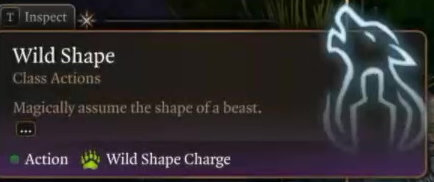
After reaching level 2, the Druid gains access to their signature ability - Wild Shape. It allows them to transform into an animal. This option is available both during exploration and combat as well.
Turning into an animal has a number of consequences:
- Druid gains new statistics, armor class, and beast stamina points, but keeps his Intelligence, Wisdom, and Charisma.
- When the Druid's hit points in wild shape drop to 0, the Druid returns to their original form as it was before the transformation.
- You can use the ability twice before making a short rest.
The best form
Each animal form has its own advantages and disadvantages. Some of them will be more useful in combat. Others will be helpful during exploration. Here are a few interesting examples of forms and their uses:
- Bear - a powerful form useful in combat. Available only for the Circle of the Moon subclass.
- Cat - a rather useless form in combat. The cat's small size is useful in thorough exploration, while the ability to meow distracts the nearby NPCs.
- Giant spider- useful in combat, and with the ability of long jump, a form that allows you to get into hard-to-reach places.
Best spells for a Druid
The spells choice will largely depend on your play style and whether your Druid will be standing on the front line or perhaps providing support for the rest of the team, casting spells from afar from the enemies.
Here are a few spells worth considering:
Cantrips:
- Guidance - a useful cantrip providing the target with 1d4 to skill checks. Choose it if your party lacks a Cleric.
- Shillelagh - your club or staff becomes a magic weapon dealing bonus damage and using your Wisdom for attack rolls. Extremely useful if you want to use blunt weapons.
- Thorn Whip - the target hit receives 1d6 damage and is pulled 3 meters towards the Druid.
Spells:
- Goodberry - a classic Druid spell creating 4 fruits that restore 1d4 health points. It can also serve as provisions when you are in a camp (provides one unit of Camp Supply).
- Cure Wounds and Healing Word - classic healing spells. The first restores 1d8 health through touch, the second 1d4 through eye contact.
- Create or Destroy Water - summons rain or removes water from a given area. Useful when paired with another magic user, because a wet opponent will take extra damage from cold and electricity.
- Thunderwave - a level 1 offensive spell. It deals 2d8 electric damage, and pushes creatures and objects away.
- Entangle - a concentration spell that creates vines that wrap around the target and immobilize it.
- Flame Blade - level 2 spell. Creates a fiery saber that deals 3d6 fire damage. The weapon also produces a blinding light. It can be holster and drawn by the caster.
- Spike Growth - Druid transforms the ground into sharp spikes. A creature moving through this area takes 2d4 damage for every 1.5 meters it walks.
- Pass without Trace - a practical spell granting the Druid and nearby companions a +10 to Stealth checks.
- Heat Metal - a level 2 spell that allows you to heat an opponent's metal weapon and armor. Depending on the opponent's actions, they may discard the weapon, receive a penalty to attacks, or receive damage from fire.
- Lesser Restoration - a level 2 spell that removes negative effects and poisoning from its target.
For more details on this topic, we invite you to visit the Best Spells section dedicated to the Druid in our guide.
Best subclass
After reaching level 2, the Druid chooses so-called Circle representing a subclass. In the early access version of Baldur's Gate 3, you can choose from the Druid's two subclasses. The third Circle will be added after the launch:
- Circle of the Land - a subclass focused on casting spells. By choosing this class at level 2, you immediately get access to 1 extra cantrip. The druid also gains access to Natural Recovery. A skill that allows you to regenerate some of your spell slots outside of combat. When reaching level 3, you will be able to choose the Spell Circle. It will provide you with 2 additional spells, which from now on will always be prepared and ready for your Druid to use. The choice of Spell Circle will ultimately depend on your play style, but it's worth paying attention to the following groups:
- Coast - you will gain access to the spells Mirror Image and Misty Step. Useful for enemy spotting.
- Underdark - you will gain access to the spells Web and Misty Step. Spells useful in combat and for surprising enemies.
- Swamp - you will get access to the spells Acid Arrow and Darkness. This Circle will suit a more offensive style of play.
At level 5, you will gain access to the next Circle. However, a pair of spells identical to those at level 3 will differ.
- Circle of the Moon - a subclass focusing on the Wild Shape, which in this subclass you can even activate during a bonus action (Combat Wild Shape). Apart from the additional form (bear), this Circle provides access to Lunar Mend starting from level 2. This ability allows the Druid in animal form to use a spell slot to recover some health points. At level 4, a Druid using Circle of the Moon also receives an additional crow form which will allow them to fly.
Circle of the Spores will be added to the game after its release on August 3rd. The materials presented above are of illustrative nature and are based on pre-release promotional materials. The section will be updated after the game's release.
- Circle of the Spores - a Circle focused on utilizing fungi, molds, and spores to control living and dead beings. The skills of a Druid of this specialization will be based on animating corpses, inflicting damage with a cloud of spores, or strengthening themselves through a symbiotic relationship with fungi.
Best build for a Druid
As a summary, below we present 2 exemplary builds for a level 3 Druid using the above tips.
Druid as a mage:
- Race: Golden Dwarf
- Subclass: Circle of the Land
- Origin: Hermit
- Abilities: Wisdom and Constitution 16, Intelligence around 14, Dexterity around 13/12, Strength around 10, Charisma around 8
- Spells Circle: Swamp
Druid as a shape-shifter:
- Race: Wood Elf
- Subclass: Circle of the Moon
- Origin: Folk Hero
- Abilities: Wisdom and Constitution 16, Dexterity about 14, Intelligence about 12, Strength about 10, Charisma about 8
You are not permitted to copy any image, text or info from this page. This site is not associated with and/or endorsed by the developers and the publishers. All logos and images are copyrighted by their respective owners.
Copyright © 2000 - 2025 Webedia Polska SA for gamepressure.com, unofficial game guides, walkthroughs, secrets, game tips, maps & strategies for top games.
